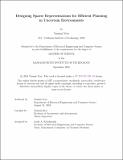Designing Sparse Representations for Efficient Planning in Uncertain Environments
Author(s)
Veys, Yasmin
DownloadThesis PDF (16.71Mb)
Advisor
Roy, Nicholas
Terms of use
Metadata
Show full item recordAbstract
We would like to enable robots to navigate efficiently in large, outdoor environments, where the traversabilities of many regions are unknown prior to planning. If we reason about the uncertainty in the environment instead of assuming that all unknown space is free to move through, we can generate policies that result in, on average, more efficient navigation. However, designing models that enable intelligent and efficient reasoning about environmental uncertainty is challenging. We would like our model to capture the underlying navigation problem and accurately represent the relevant uncertainty, yet remain as sparse as possible, so that planning remains tractable. Higher model expressiveness improves plan quality but reduces computational efficiency in planning, whereas higher model sparsity improves efficiency at the cost of plan quality. Balancing model expressiveness and model sparsity, thus, is crucial for generating high quality plans efficiently. In this thesis, we describe several useful models for planning under uncertainty and justify our decision to use weighted stochastic graphs with probabilistically traversable edges. We then present a novel method of efficiently generating sparse stochastic graphs given coarse information derived from overhead images of our environments. We test our approach in several simulated environments, demonstrating that our graphs effectively trade off between plan quality and planning efficiency for uncertainty-aware agents navigating in the graph. We then deploy our algorithms in a real-world environment on real-world hardware for single-agent and multi-agent teams. We discuss the challenges associated with using our approach in the field and the implications of our model assumptions not matching the real world. Finally, we present preliminary results for adding cost uncertainty to our graph-based representation.
Date issued
2024-09Department
Massachusetts Institute of Technology. Department of Electrical Engineering and Computer SciencePublisher
Massachusetts Institute of Technology